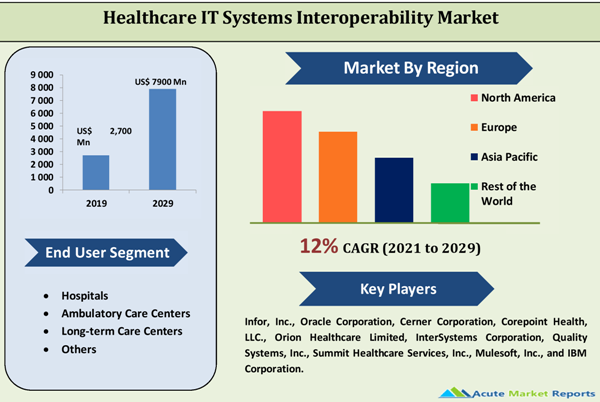Report Description:
The Healthcare IT Systems Interoperability Market was valued at US$ 3,348 Mn in 2021 and expected to reach US$ 8,848 Mn by 2033, expanding at a CAGR of 12% from 2025 to 2033. The healthcare IT systems interoperability solution aids in seamless exchange of data associated with patients between hospitals and other healthcare facility providers within healthcare industry. Effective deployment of healthcare IT systems and real-time use of medical information through healthcare IT systems interoperability has allowed medical facilities to provide first-rate treatment and care to their patients.
Cost Cutting Benefits the Demand for Interoperability Solutions
Cost associated with healthcare in developed countries in North America and Europe regions has skyrocketed over the years. Incorporation of effective techniques such as healthcare IT systems interoperability is highly encouraged by healthcare and medical facilities in order to mitigate the exponential cost of medical treatments. Aforementioned factors have certainly created a positive outlook on the growth of overall Healthcare IT Systems Interoperability market. Challenges such as lack of standardization, complexity and high cost of installations have restrained the growth of Healthcare IT Systems Interoperability market. However, aforementioned challenges are expected to diminish during the forecast period from 2021 to 2029.

Remote Management & Integrated Access Remain Key During & Post Pandemic Scenario
Healthcare IT Systems Interoperability has gained immense popularity in the recent years. Rising healthcare costs and increasing need to provide effective healthcare services have led to the growing demand for healthcare IT systems interoperability. The integration of various systems enables healthcare organizations to reduce number of repeated tests and making it easier for medical staff to access patient medical data. Furthermore, with interoperability between various healthcare systems, medical professionals easily and securely can share medical information for expert consulting and referrals. Thereby, interoperability ensures continuity of care irrespective of geographical location or healthcare service provider. Furthermore, interoperability enables governments and healthcare organizations to deploy population health management that can work towards prevention and early detection of diseases.
Hospitals are the Key Users of Interoperability Solutions
Interms of biotechnology, pharma, clinical trials, R&D and healthcare IT the industry the market has evidenced significant growth post the temporary setback during the lockdown that impacted the operations of the pharma and biotech companies. However, critical R&D laboratories and healthcare service centers and services are continuing to remain under significant strain during this period. The hospitals segment held the largest market share in the overall Healthcare IT Systems Interoperability Market across the world in 2020. With numerous IT systems deployed in large acute care settings, it has become imperative for hospitals to achieve enhanced interoperability among various systems to reduce healthcare costs and increase clinical workflow efficiency.
North America Generates Almost Half of the Revenues
North American region comprising Canada, the U.S. and Caribbean countries held the largest share in the overall Healthcare IT Systems Interoperability market. The region accounted for 48% of the global market value in the year 2020. The U.S. represented the largest and most attractive Healthcare IT Systems Interoperability Market owing to need for effective use of healthcare IT systems. With the advent of technological advancements in the healthcare IT sector, large volumes of data is being generated using various medical systems and devices at healthcare facilities. In order to reduce healthcare costs along with gaining actionable insights, it has become imperative for healthcare organizations to connect and integrate various healthcare IT systems deployed within the organization. Healthcare IT systems interoperability platforms have enabled healthcare providers to seamlessly collate and analyze the data generated at various points. Healthcare facilities can further make use of this integration to enhance clinical workflow and reduce redundancies.
Key Market Players
In order to help strategic decision makers, the report also includes competitive analysis and profiling of the leading providers of healthcare IT systems interoperability, market positioning and key developments. Some of the major players profiled in the report are Infor, Inc., Oracle Corporation, Cerner Corporation, Corepoint Health, LLC., Orion Healthcare Limited, InterSystems Corporation, Quality Systems, Inc., Summit Healthcare Services, Inc., Mulesoft, Inc., and IBM Corporation.
Historical & Forecast Period
This study report represents analysis of each segment from 2023 to 2033 considering 2024 as the base year. Compounded Annual Growth Rate (CAGR) for each of the respective segments estimated for the forecast period of 2025 to 2033.
The current report comprises of quantitative market estimations for each micro market for every geographical region and qualitative market analysis such as micro and macro environment analysis, market trends, competitive intelligence, segment analysis, porters five force model, top winning strategies, top investment markets, emerging trends and technological analysis, case studies, strategic conclusions and recommendations and other key market insights.
Research Methodology
The complete research study was conducted in three phases, namely: secondary research, primary research, and expert panel review. key data point that enables the estimation of Healthcare IT Systems Interoperability market are as follows:
Market forecast was performed through proprietary software that analyzes various qualitative and quantitative factors. Growth rate and CAGR were estimated through intensive secondary and primary research. Data triangulation across various data points provides accuracy across various analyzed market segments in the report. Application of both top down and bottom-up approach for validation of market estimation assures logical, methodical and mathematical consistency of the quantitative data.
| ATTRIBUTE | DETAILS |
|---|---|
| Research Period | 2023-2033 |
| Base Year | 2024 |
| Forecast Period | 2025-2033 |
| Historical Year | 2023 |
| Unit | USD Million |
| Segmentation | |
End User
| |
|
Region Segment (2023-2033; US$ Million)
|
Key questions answered in this report